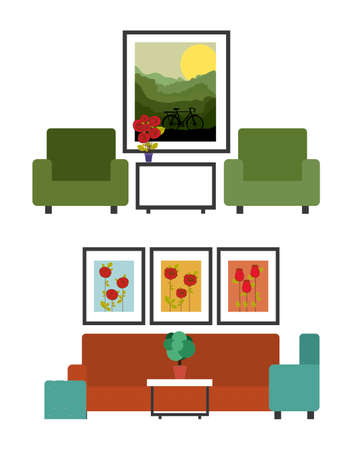Understanding Lighting Scenes in the Home
In recent years, lighting scenes have become a popular feature in many UK households, transforming the way we interact with our living spaces. But what exactly are lighting scenes? Simply put, a lighting scene is a pre-set arrangement of lights, brightness levels, and sometimes colour temperatures designed to suit specific activities or moods within your home. For example, you might have one scene for reading in the lounge, another for entertaining guests in the dining room, and yet another for winding down before bed. The practicality of lighting scenes lies in their ability to adapt your environment at the touch of a button or even automatically via smart home systems. With the often unpredictable British weather and varying daylight throughout the year, customisable lighting helps maintain comfort and functionality regardless of external conditions. Whether youre seeking energy efficiency, convenience, or simply a more pleasant atmosphere, understanding how to leverage lighting scenes is essential for any modern UK household aiming to blend tradition with technological innovation.
Popular Lighting Scene Ideas for British Homes
Lighting scenes are an increasingly popular way to adapt the mood and functionality of UK homes, reflecting both traditional sensibilities and modern living habits. Customising lighting scenes isn’t simply about changing brightness; it’s about crafting environments that suit daily routines, social gatherings, and moments of relaxation. In this section, we’ll explore some typical scene setups that are especially well-suited to British homes, each designed with local preferences and lifestyle in mind.
Typical Scene Setups in the UK
British households often favour a few classic lighting scenes, each tailored to a particular time of day or activity. Below is a breakdown of these popular configurations:
| Scene Name | Description | Common Settings |
|---|---|---|
| Cosy Evening | Perfect for winding down after a long day, this scene uses warm tones and soft illumination to create a snug and relaxing atmosphere. | Warm white (2200K–2700K), dimmed lights, focus on table and floor lamps, minimal overhead lighting |
| Dinner Party | Designed for hosting friends or family, this scene accentuates the dining area while keeping surrounding spaces gently lit for comfort and conversation. | Soft white (2700K–3000K), brighter over dining table, dimmed elsewhere, accent lighting for decor |
| Early Morning | Aims to energise without harshness at the start of the day, using cooler but gentle light that mimics natural daylight. | Cool white (3500K–4000K), gradual increase in brightness, focus on kitchen and bathrooms |
| Reading Nook | For those who love a good book, this scene provides focused yet comfortable illumination in dedicated corners or alcoves. | Neutral white (3000K), localised task lighting, adjustable brightness for eye comfort |
| Movie Night | This setup creates an immersive cinema feel by reducing glare and focusing subtle light away from screens. | Very dim warm light, optional coloured accents (e.g., blue or red), blackout blinds if available |
Reflecting British Lifestyle Preferences
The appeal of these scenes lies in their alignment with British indoor lifestyles: evenings spent with family, sociable weekends with friends, early mornings preparing for work or school, and quiet moments set aside for hobbies. By customising lighting scenes according to these patterns, homeowners can enhance not only the look but also the feel of each room—making everyday life more comfortable and enjoyable.

3. Integrating Smart Controls with Existing Fixtures
Upgrading to smart lighting in the UK doesn’t mean you have to rip out your traditional fittings or overhaul your property’s wiring. Whether you own your home or are renting, there are practical ways to incorporate modern smart controls with classic UK light switches and fixtures. Below, we’ll walk through the process, offering tips tailored to typical British homes.
Understanding Traditional UK Fittings
The vast majority of UK homes use standard bayonet or Edison screw fittings, and wall switches are usually single-pole with a neutral wire often missing at the switch. This can complicate installation of some smart devices, so it’s important to check compatibility before purchasing any kit.
Smart Bulbs: The Plug-and-Play Solution
If you’re in rented accommodation or want minimal fuss, smart bulbs are the most straightforward option. Simply replace your existing bulbs with smart alternatives from brands like Philips Hue or IKEA TRÅDFRI. These work with your current sockets and require no electrical work—control comes via an app or voice assistant.
Smart Switches and Dimmers: For Homeowners
If you own your home and want a more integrated look, consider replacing traditional wall switches with smart versions. In the UK, be sure to choose models compatible with “no neutral” wiring if that’s what you have. Some brands offer retrofit solutions specifically for older British wiring standards, making installation easier without major rewiring.
Wireless Remotes and Stick-On Controls
For renters or those wanting a non-permanent setup, wireless remotes and stick-on smart switch panels (like those from Lutron or Lightwave) provide flexible control. These can be attached anywhere in your flat without damaging walls—a perfect workaround for keeping landlords happy while enjoying scene control in each room.
Tips for Rented Accommodation
- Opt for smart bulbs over hardwired switches to avoid issues during tenancy checks.
- Use battery-powered remotes for additional control without altering fixtures.
- Keep original bulbs and switches handy for easy reversion when moving out.
Summary
Integrating smart controls into British homes is achievable regardless of property type. By choosing compatible devices and non-invasive solutions, both homeowners and renters can enjoy customisable lighting scenes tailored to their lifestyle while respecting local standards and regulations.
4. Creating and Scheduling Your Own Scenes
Personalising your home’s lighting is a straightforward process thanks to the many smart lighting products available in the UK, such as Philips Hue, LIFX, Hive Active Lights, and others. This section provides a step-by-step guide to setting up customised lighting scenes and automating schedules for everyday convenience and energy efficiency.
Step 1: Selecting Compatible Devices
First, ensure your chosen smart bulbs or switches are compatible with your preferred ecosystem—be it Amazon Alexa, Google Home, Apple HomeKit, or a proprietary app from brands like Hive or LightwaveRF. Most leading brands support integration with major UK smart home platforms.
Step 2: Installing Your Smart Lighting System
- Replace existing bulbs with smart bulbs or connect smart switches following manufacturer instructions.
- Connect devices to your Wi-Fi network via the associated mobile app (Philips Hue, Hive, etc.).
- Name each light or zone clearly for easy identification (e.g., “Living Room Lamp” or “Kitchen Ceiling”).
Step 3: Creating Custom Scenes
- Open the relevant app and navigate to ‘Scenes’ or ‘Routines’.
- Select which lights you’d like to include in the scene.
- Adjust brightness, colour temperature, and even colour (if supported) to suit specific activities—such as reading, relaxing, or entertaining.
- Save your custom scene with a descriptive name (e.g., “Cosy Evening”, “Wake Up”, “Movie Night”).
Example Scene Settings Table
| Scene Name | Location | Brightness (%) | Colour/Temperature |
|---|---|---|---|
| Morning Boost | Kitchen | 100% | Cool White (6500K) |
| Evening Relax | Lounge | 40% | Warm White (2700K) |
| Dinner Party | Dining Room | 80% | Slightly Warm (3000K) |
Step 4: Scheduling Automated Routines
- Select your saved scene within the app’s scheduling section.
- Set time triggers (e.g., weekdays at 6:30am for wake-up lights).
- Add conditions—many systems allow sunset/sunrise automation based on your UK postcode.
Troubleshooting Tips:
- If a schedule fails, check Wi-Fi connectivity and that all devices have updated firmware.
- For multiple users in a household, ensure everyone’s preferences are considered when naming scenes and setting routines.
This hands-on approach empowers UK homeowners to create tailored atmospheres for every occasion while making everyday living more convenient and efficient.
5. Energy Efficiency and Cost Considerations
When customising lighting scenes in UK homes, energy efficiency and cost management are essential factors to consider. With rising electricity prices and the government’s focus on sustainability, making informed decisions about your lighting setup can have a significant impact on both your carbon footprint and monthly bills.
Understanding Your Tariff
Start by reviewing your current electricity tariff. Many UK households are now on variable rate or time-of-use tariffs, such as Economy 7 or smart meter-based plans. These offer lower rates during off-peak hours. By scheduling certain lighting scenes—like outdoor security lights or accent lighting—to operate primarily during cheaper periods, you can make tangible savings.
Optimising Scene Settings for Efficiency
Choose LED bulbs and smart controls wherever possible, as these consume far less energy than traditional incandescent or halogen bulbs. Adjust scene brightness to suit the activity: for example, use dimmed settings for evening relaxation rather than full brightness. Integrate motion sensors in corridors, bathrooms, and utility rooms so lights only activate when needed, further reducing unnecessary consumption.
Leveraging Automation Features
Smart home systems can automatically adapt lighting based on occupancy or daylight levels. In the UK’s variable climate, using daylight sensors ensures artificial lighting is only used when natural light isn’t sufficient. Set up routines that gradually reduce brightness as you wind down for the night, helping both with sleep quality and energy saving.
Exploring Incentives and Support
The UK government occasionally offers incentives for energy-efficient home upgrades, such as the Energy Company Obligation (ECO) scheme. While direct grants for lighting may be limited, upgrading to efficient systems can sometimes be supported through broader home improvement packages. Always check local council websites or trusted sources like the Energy Saving Trust for up-to-date information.
By tailoring your lighting scenes with efficiency in mind—selecting appropriate technologies, leveraging automation, and aligning usage with favourable tariff periods—you not only enhance comfort but also contribute to a more sustainable and cost-effective UK home.
6. Troubleshooting and Maintenance
Setting up customised lighting scenes in UK homes can occasionally come with its own set of challenges. Fortunately, most issues are common and can be resolved with a bit of patience and know-how. Below, we’ll walk through typical problems faced by UK households and provide straightforward solutions and maintenance advice to keep your lighting system running smoothly.
Common Issues and Their Solutions
Connectivity Problems
A frequent hiccup is the loss of connection between smart lighting devices and the home Wi-Fi network, particularly in older properties with thick walls. If you’re experiencing intermittent control or delayed responses, try relocating your router or adding a Wi-Fi extender closer to your lighting hub. Ensure all firmware updates are installed for both your router and smart devices.
Scene Not Activating Properly
If a customised scene isn’t activating as expected—perhaps certain lights don’t respond or settings revert—double-check the scene configuration in your app. Sometimes, accidental overrides or manual switches can disrupt programmed scenes. Re-save your scene preferences and ensure all bulbs or fixtures are included in the setup.
Compatibility Concerns
In UK homes with a mix of traditional fittings and modern smart bulbs, compatibility issues can arise. Always verify that your switches, dimmers, and bulbs are suited for one another. For best results, opt for products from the same manufacturer or those certified to work together under established standards such as Zigbee or Z-Wave.
Maintenance Tips for Long-Term Performance
Regular Software Updates
Manufacturers frequently release updates that enhance performance or patch security vulnerabilities. Set reminders to check for updates within your lighting app every few months.
Physical Cleaning
Dust and debris can reduce bulb efficiency and affect sensor accuracy. Gently wipe down light fixtures and sensors periodically using a dry cloth.
Check Wiring and Power Sources
If you notice flickering or complete loss of power, inspect wiring connections (with power off) or consult a qualified electrician. In older UK homes, wiring standards may differ—never hesitate to seek professional advice when unsure.
When to Call an Expert
If persistent issues remain unresolved after basic troubleshooting, it’s wise to consult a certified electrician familiar with smart home systems. This ensures safety compliance with UK regulations and gives peace of mind for ongoing use.
By proactively addressing these common challenges and following regular maintenance routines, you’ll enjoy reliable, flexible lighting scenes that enhance comfort and atmosphere throughout your UK home.


